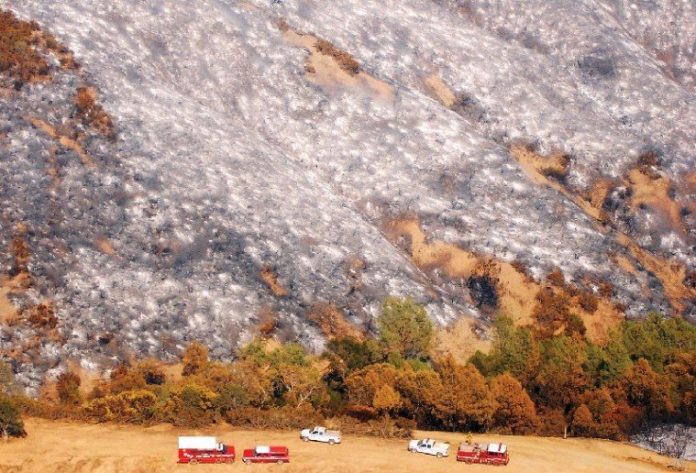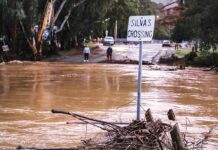The Lick Fire destroyed nearly 50,000 acres and has cost nearly
$11 million to douse, but there are some Gilroyans who benefited
from the ordeal.
Gilroy – The Lick Fire destroyed nearly 50,000 acres and has cost nearly $11 million to douse, but there are some Gilroyans who benefited from the ordeal.
Hotels, coffee shops, restaurants, gas stations and general stores all welcomed the troops of tired, hungry firefighters and their diesel equipment, though City Administrator Jay Baksa said the rush of economic activity wouldn’t result in more than “a blip” on the city’s financial radar at the end of the fiscal year.
Big picture aside, though, there has been an average of 1,450 firefighters in Gilroy each day since Sept. 3, staying at either Christmas Hill Park or in hotels, according to CalFire figures. As of Wednesday morning, CalFire had spent more than $270,000 on lodging, which boils down to $24,300 for the city since hotels charge a 9 percent “transient occupancy tax” for dwellers who use Gilroy’s water, electricity and sewer systems.
As the manager of the Forest Park Inn on Leavesley Road near U.S. 101, Mike Patel said he filled 90 rooms with sleepy firefighters for four to five days. Each room runs $109 per night, he added, but the government receives a 10-percent discount. Moti Kika filled about 20 rooms throughout last week at his Super Motel 8 on San Ysidro Avenue near U.S. 101 at $60 a piece.
“They really helped us out,” Patel said, referring to the fact that this time of year is slow for hotels since the summer vacation season has ended. But with the Lick Fire, Patel said he had to turn civilians away to accommodate the sudden influx, which was “kind of stressful” even though it was good for business.
“We had a lot of people driving by and asking why we didn’t have any rooms,” Patel said, “and I told them, ‘Well, it’s because of the firefighters.’ ”
The Ramada Limited on Leavesley Road between Forest Street and Murray Avenue didn’t have a large enough parking lot to accommodate the fire trucks, its manager said.
The size of Mike Gray’s parking lot didn’t matter, though. He said firefighters were coming in and out from surrounding hotels to eat at the Black Bear Diner he manages.
“It would fill up one day, and then they would go somewhere else for dinner the next,” Gray said, “but absolutely, it was good for business.”
Across the street Ida Freitas, an attendant at Rotten Robbie, said she saw about four to six fire trucks pull up for diesel on Sunday alone, and it had been about the same for most of the previous week. Each truck costs about $85 to $90 to fill. At the Valero at the corner of First Street and Westwood Drive on the west side of town, Manager Elena Rodriguez said she had seen about four trucks a day for the past week, each averaging about $85 in fill-up charges.
And how else are exhausted firefighters supposed to fight a massive fire except with coffee?
Area Starbucks Coffee Shops teamed up with CalFire to donate coffee and pastries.
Rachelle Voshall, the assistant manager the Starbucks at Gilroy Crossing, said she had seen about 50 firefighters every morning throughout last week, but never less than 25.
“It helped us out, but at the same time, we were donating a lot of products,” Voshall said, referring to nine 5-gallon jugs of coffee, which normally cost $90 each, that the store donated to CalFire. Jaimi Farley, the shift supervisor at the Starbucks in the Nob Hill center on First Street, said she had also seen about 25 to 30 firefighters each morning for the past week, buying drinks ranging from a couple of bucks to $4 or $5.
Firefighters also needed everything from toothpaste to Advil, boosting sales among drug stores and big-box retail chains.
But Baksa said while this sudden spending is normal for abrupt disasters, blazes like the Lick Fire are few and far between. He added that most of the firefighters had stayed in Christmas Hill Park, and as far as the spending’s concerned, “It will not have a significant outcome for [the city’s] tax revenue,” Baksa said. Tax reports are due to the city by Oct. 31 for the quarter ending Sept. 30.
Jane Howard disagreed with Baksa and said she expects high returns.
“The byproduct of this fire – even though it’s very inconvenient in terms of smoke and air quality – the economic impact of the community is going to be significant,” said Howard, who works at the Visitor’s Bureau.
But at the Chamber of Commerce, Susan Valenta said it didn’t matter if sales were up or down. The economic impact isn’t important in the big picture, she said, but rather Gilroy’s role as CalFire’s home base and the sacrifice of the CalFire men and women.
“As a community – whether it was a negative or positive economic impact – it was a tragedy,” Valenta said. “It wasn’t meant to be an economic benefit … And it’s not the same as when we’re looking at business development because we have control over that.”















